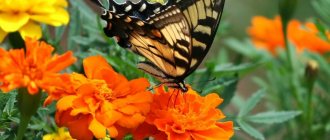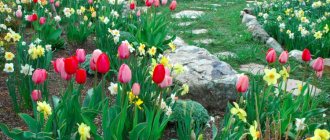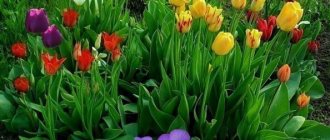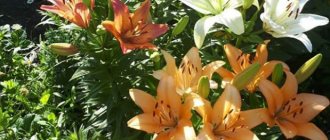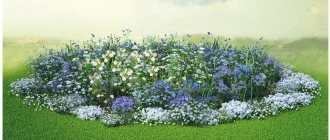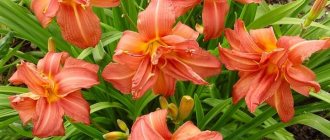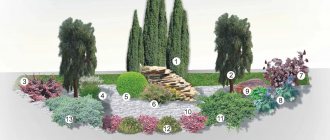If you try hard, you can grow a real star in your summer cottage. Aster lends itself very well to planting and caring for in open ground. In this article you can find a description of the plant and its varieties. Here you can find information about propagation, cultivation and combination with other plants. Learn a lot about the use of aster in landscape design using the example of country photos.
Description: varieties and varieties of aster
The culture has earned universal recognition due to the variety of plant forms: from miniature to giant shrubs, which are decorated with flowers of various shapes and shades.
Perennial asters
Alpine aster
This type of plant includes a wide variety of subspecies and series of varieties.
Alpine aster. Blooms earlier than other varieties. Already at the end of May you can see the buds blooming on it. The bushes are short - 20-25 cm. The leaves form beautiful bushes in the shape of a hemisphere. The color of the flowers of this variety of asters is replete with its diversity. There are both white and pink, dark purple with a bluish tint, flowers with a bright orange eye. The most common varieties:
- Gloria - blue flowers with a bright orange center;
- Vargrav - pink flowers with a yellow eye;
- Albus – snow-white flowers;
- Abenshain - double soft pink flowers with a yellow center.
Mongolian aster. It blooms in mid-July and belongs to the summer-flowering type of crop. It gets its name due to its territorial origin: this series of varieties comes from Mongolia. The bushes reach 1 m in height, flowering is quite abundant with large loose rosettes. Loves sunlight and tolerates frost well.
New England aster
American (New England) aster. Blooms late - in mid-autumn. In the southern regions it can bloom in November. Huge bushes reach a height of 2 m. It has large bright flowers of unusual shades for an aster. The most popular:
- September Ruby – red flowers with a light eye;
- Violetta – flowers of rich purple color;
- Purple Cloud – tall bushes with huge lilac flowers;
- Kylie is a frost-resistant aster (tolerates nighttime temperature drops down to -5 °C), the bush is dotted with small pink flowers.
Italian aster
Chamomile (Italian aster). The flowering period begins in August, the flowers are small lavender in color, collected in inflorescences in the form of umbrellas of several pieces.
- Ultramarine - purple flowers with blue tips and a yellow center;
- Violet Queen is the most common variety in this series and has beautiful purple blooms.
Annual asters
Plants of this type have a limited growth time. This flower must be planted every season. Varieties of annual asters differ in the shape of the inflorescence:
Peony asters. Small decorative bushes up to 70 cm tall. The flowers are large, up to 15 cm in diameter. The peduncles are long, with 1 flower on each. These asters are mainly used as cut decoration. The combination of various varieties of asters in a bouquet looks stunning. The most popular variety of peony-shaped annual asters, which have a tall spreading bush with double reed flowers up to 13 cm in diameter, is “Ostrich Feather”. Its peduncles are long and elastic.
Aster annual peony
Chrysanthemum-shaped asters. This variety series is named so because the flowers of the plants resemble chrysanthemums. A striking representative of this series is “Apolonia”. The bush is formed in a pyramidal manner with a height of about 65 cm. The flowers are large - 10-11 cm. 10 or more rosettes can bloom simultaneously on the bush.
Globular asters. They got their name from the shape of the inflorescences. The most popular variety is “Martian”. The bushes are low, up to 45 cm. It has strong peduncles, 42-45 cm long. It produces up to 17 small (5 cm in diameter) flowers on one plant.
Needle asters. They are called so because of the shape of the false-lingual petals on the inflorescence, twisted into a tube and resembling long needles. The variety "Cassandra" has become widespread in the central and southern regions. The bushes are tall up to 80 cm, growing upright. Good strong peduncles, the length of which is 35-40 cm. Up to 17 inflorescences with a diameter of 10 cm can form on the bush.
Needle aster
The variety of asters allows them to be grown for use in landscape design and for creating cut flower decorations.
Collection and storage of seeds
A peculiarity of asters is the ripening of seed material 1.5-2 months after the appearance of the first inflorescences. In some cases, the time to collect grains falls during prolonged rains or autumn frosts, which often leads to the death of flowers.
Many gardeners cut off the heads of asters in advance and place them on the windowsill, but such seed material does not always produce good seedlings.
To preserve germination, it is necessary to dig up the plant and transplant it into a flowerpot, which is then installed on the windowsill. The crop will take approximately two or three weeks to ripen. All this time, the bush needs to be rotated around its axis so that it receives a sufficient amount of sunlight.
After the inflorescences wither and the petals dry out, a dark spot and fluff will appear in the center of the flower. At this time, you need to pick the heads and place them in a paper bag, which should be stored in a dry and warm room. The packaging must indicate the date of seed collection, aster variety and color. We do not recommend storing seeds for a long time; after two years, their germination capacity will decrease by 2.5 times.
Planting a plant
Planting asters in open ground is done after selecting a suitable site. A permanent location should be selected taking into account the light-loving nature of the plant. You should also prepare good drainage for the flowers. Astra feels best in the place where calendula grew before.
If planting is done by seedlings, then first you need to sow seeds in open ground. The sprouts sprout in 5-7 days. After 3-5 developed leaves appear on them, picking and thinning are performed. Next, the asters are planted in a permanent place.
Aster should be planted in a well-lit area
The most favorable time for planting young asters is mid-spring. Already in April the air temperature is suitable. Planting of seedlings is carried out in the evening.
In order to prepare the soil, it is necessary, in the fall, to deeply dig up the plot of land in which asters are supposed to be planted, adding humus or compost (2 kg/m2) to the soil. After the snow melts, the area is dug up again. If the soil is poor, then 30 g/m2 of superphosphate and 20 g/m2 of potassium salts must be added to it.
Important! The first watering is not performed at planting, but after 2-3 days.
Sowing perennial aster seeds for seedlings
Using the seedling method, perennial aster seedlings are grown in the same way as annual ones. Sowing is carried out in the second half of March - early April. The hatched seeds are lowered into cassettes or a small container with fertile soil into pre-made grooves to a depth of 0.5 cm. The container is covered with plastic film or a plastic lid and kept in a well-lit room at a temperature of 18-22°C.
Shoots usually appear after 3-5 days. After this, the container is opened slightly and, if necessary, the soil is moistened with a spray bottle. During the day, seedlings are kept at a temperature of about 20°C, and at night – at 15-17°C. The place should be bright (a window sill is suitable) and well ventilated.
In the phase of three true leaves, the seedlings are planted in separate small cups or cassettes.
10-12 days after picking, asters are fed with ammonium nitrate (1 g per 1 liter of water). After another 2 weeks, 1.5 g of ammonium nitrate, 1.5 g of potassium sulfate and 3 g of superphosphate are added to the soil. Fertilizers are diluted in 1 liter of water.
Plant care
Aster is not a very demanding crop, so caring for it does not take much time and effort. The main thing is to loosen the soil and remove weeds in time. This procedure must be performed after watering has been carried out or it has rained.
Transplanting a young plant into the ground
Watering is important for aster. But here it should be taken into account that they tolerate excess moisture just as painfully as lack. In hot weather, it is better to water asters growing in open ground less often, but more abundantly (30 l/m2). If watering is not done on time, the inflorescences may lose their decorative appearance.
Care also includes timely removal of dried flowers and leaves. This should be done in the morning so that the plant has time to heal the wounds. If dead or diseased areas of the flower are not removed, the plant will waste nutrients to restore them.
It is very important to maintain the optimal watering regime so that the plant feels good. Advice. In order for the aster to delight you with its beauty, planting and care must be done correctly.
Growing and care
Care is limited to watering, pruning in March (dry stems can simply be broken off), from time to time the plants need to be fertilized and watered moderately. Asters should be weeded regularly so that perennials do not have to compete with other plants for water and nutrients.
Feeding and watering
Only tall species need to be fertilized in the spring with a dose of compost. Asters are fertilized before flowering, during the growing season of the plant. You can use multi-component fertilizers to feed asters, but you should remember that excess nitrogen causes a deterioration in flowering. In autumn it is useful to feed asters with compost.
Watering should be regular and abundant, especially during periods of drought, otherwise the leaves will begin to dry out from below, which will lead to weakening and reduction of flowering.
Trimming
Faded flower stalks are cut off in the spring to a few centimeters above the ground. Healthy plant parts can be placed in a composter. If plants are affected by powdery mildew, cut stems are only suitable for garbage. Bush aster (Symphyotrichum dumosum) grows into a dense carpet. To ensure that the plants maintain a beautiful, compact appearance, they are cut to half their height before flowering and fed with compost.
During the summer months, trimmed stems of New England aster (Symphyotrichum novae-angliae) and American aster (Symphyotrichum laeve) branch out and bloom later, longer, and more abundantly. Autumn asters are trimmed flush to the ground after flowering.
Rejuvenation and transplantation
Not only for propagation, but also in order to maintain an abundance of flowering for many years, plants should be regularly dug out of the ground, divided and replanted. This procedure is carried out every few years. Asters are perennial flowers, but over time they die off - the middle part of the bush dries out.
In early spring, the youngest underground rhizomes should be separated and transplanted to a new location. This will have a positive effect on flowering and reduce the risk of fungal diseases, to which aster plants are sensitive.
Wintering
These perennials are completely frost-resistant and do not need shelter for the winter. They can freeze only during very frosty and snowless winters.
Protection from diseases and pests
Most often, asters are affected by fungal diseases, especially powdery mildew. You can protect plants from powdery mildew by choosing varieties for planting that are resistant to this disease. Autumn varieties should be placed in sunny, ventilated places. Powdery mildew can also be promoted by over-fertilizing, so it is better to use organic fertilizers. Leaves affected by the fungus should be removed and destroyed, and not thrown into the composter.
On too light or too heavy soils, as well as in the event of unfavorable weather, asters are susceptible to fusarium. Plants wither and turn yellow, the lower parts become covered with plaque.
Diseased specimens must be removed, the remaining ones must be thoroughly sprayed with fungicide. Aster trees can only be planted in the same place after a few years; the disease may remain in the soil.
Shrub varieties are quite susceptible to pests; their thick, fleshy leaves are a delicacy, especially for aphids and slugs. Therefore, it is worth paying attention to preventive spraying against pests.
Fertilizing and feeding aster
An important step in growing all varieties of aster is feeding. During the entire season it is necessary to apply fertilizer at least three times.
10 days after planting:
- ammonium nitrate 20 g/m2;
- potassium sulfate 10 g/m2;
- superphosphate 50 g/m2.
When the first bud appears:
- potassium sulfate 10 g/m2;
- superphosphate 50 g/m2.
Aster must be fertilized several times per season.
When flowering begins:
- potassium sulfate 10 g/m2; superphosphate 35 g/m2.
Timely fertilization of the soil will allow the plant to delight you with a much larger number of new blooms.
Plant propagation
Growing an aster involves its subsequent propagation, which is done using seeds and dividing the bush. Planting seeds of annual asters in open ground is done in the spring no later than 2-3 years after they are collected. And perennials are sown at the end of the season in the fall, immediately after collecting the material.
Aster seeds
Perennial asters are also bred vegetatively (by dividing the bush). If the plant is divided in the spring, then in the fall you can observe the flowering of its separated part. Astra tolerates division very easily. Propagation by the vegetative method is carried out when the separated part has 4 new shoots, one bud and several roots.
From May to August, asters can be propagated by cuttings. Apical cuttings (6 cm) are chosen as planting material. Reproduction is carried out by planting the material in a prepared mixture of turf, peat and sand. After a month, the cuttings take root completely.
Seedless growing method
You don't have to do much here. We have already talked about the place. Sow seeds in rows; the soil must be prepared in advance. You can dig a bed, pour humus along the entire length, and sprinkle it with an additional complex preparation. After which the seeds are sown and sprinkled with a layer of soil. In this case, you can plant both in spring and before winter. In the latter case, the asters will bloom a couple of weeks later, but the flowering itself will last longer.
On a note! People often ask when asters bloom. There is no definite answer, since it all depends on the variety you choose. Some flowers are pleasing only towards the end of summer, while others can bear buds as early as May. Usually the dates are indicated on the seed packages.
When using the seedless growing method, the following rules are important:
- if you sow seeds in the spring, then the soil should already be moderately warmed up - late April - early May. In autumn, sow around October under a layer of mulch. This could be sawdust or compost. In the spring, the beds are only weeded around, but the mulch is not touched until the shoots appear;
- in both spring and autumn, it is better to pour boiling water with potassium permanganate onto the soil - both disinfection and additional heat;
- do not make the beds deeper than 2 cm;
- mark your plantings so that they are not trampled later or dug up;
- do not forget to water the area with asters with warm water, but this is done very rarely if the soil has already become too dry and it is quite hot outside;
- when the seedlings are approximately 4-5 cm long, they need to be planted, it is better to do this in the evening hours and also strictly according to the dates of the lunar calendar.
Diseases and pests
Asters, like any other plants, are susceptible to attacks by pests and pathogens. This crop is also affected by viral diseases. Signs of disease appear on the stems, leaves and inflorescences of the plant. The growth of the affected specimen slows down, the flowers become deformed and may die.
Pest of asters - crop slug
To avoid losses among plantings, it is necessary to use high-quality planting material and choose virus-resistant varieties. Proper crop care can also be preventative.
The most dangerous for asters are insects that carry viral infections.
Tilled slug. It feeds on the green part of the plant. Eats leaves and sometimes buds. When a crop is infected by this pest, oblong holes form on the leaves and mucous discharge is observed. Slug reproduction occurs in conditions of high humidity.
You can fight it by destroying weeds and carrying out autumn plowing. Sprinkling lime along the boundaries of the area will also help.
Earwig. Adults are especially dangerous. The attack by these insects occurs in the second half of June. They feed on aster buds, inflorescences and leaves.
Earwig
The main method of control is pollination of plants with foundationazole.
Aster blizzard. This is a small butterfly (20 mm wingspan). Both adults and caterpillars are dangerous. Attacks by these insects most often occur during the flowering period. Adults lay eggs in the inflorescence; the caterpillars first feed on pollen and then eat the entire flower.
To avoid such attacks, it is necessary to prevent asters from being planted close to sunflowers. It is also necessary to treat the soil before planting with bazudine, since the caterpillar pupates and overwinters directly in the soil.
Spider mite. A small insect of a yellow hue, located on the bottom of the leaf and sucks the juice from it. Damaged leaves dry out and fall off. Active tick reproduction occurs in dry weather.
Spraying the plant with a solution of 0.2% karbafos or onion infusion will help cope with the pest. To prepare it, you need to put 100 g of warm onions in a 3-liter jar of water, seal it and leave for 8 hours. Strain the liquid and add another 7 liters of water. To improve the effect, add 45 g of liquid soap.
The most dangerous diseases of asters include:
Fusarium
Fusarium. It is caused by the fusarium fungus, which is found in the soil in the form of spores. The fungus enters during the absorption of nutrients by the roots and clogs the entire vascular system of the plant. It appears as dark stripes on the stem and wilting of leaves on one side. You can also notice a pinkish coating on the root area - this is the mycelium of fusarium. Spreads when humidity rises.
The disease can be combated by adding lime and etching the planting material in a foundation solution. Steaming the soil will also help prevent fungus formation.
Jaundice of aster. A viral disease that can infect a plant with cicadas and aphids. It manifests itself as lightening of the leaf plate along the veins. As the disease progresses, growth suppression is observed. The buds turn green and stop developing.
Jaundice of asters
To prevent the development of the disease, it is necessary to destroy the carriers of the virus. Affected plants are removed and burned. Aphids are fought with a decoction of yarrow; each bush of asters growing in open ground is sprayed with it.
Blackleg. A disease caused by a fungus. Young plants are affected. It manifests itself as blackening of the root neck and stem base. The pathogen actively develops in acidic soil.
To prevent the disease, young asters are picked early and the root area is sprinkled with sand. If a disease is detected, the affected plants are removed and the soil is disinfected.
Description of lavender
This is one of the most famous plants, which is in great demand all over the world. Lavender is native to the Mediterranean coast, but despite this, it grows well at home. The flower belongs to the group of perennial, evergreen plants. It is presented in the form of a subshrub with numerous shoots. In nature, lavender can grow up to 60 centimeters in height.
Useful properties of the plant:
- restores the functioning of the nervous system;
- normalizes sleep;
- is a good remedy for the prevention of cardiovascular diseases;
- improves the functioning of the digestive tract;
- has anti-inflammatory and antimicrobial properties;
- relieves muscle fatigue;
- improves joint function;
- restores natural skin color;
- helps improve hair condition.
A lack of light can lead to seedlings stretching out, which will negatively affect their further development. Therefore, in cloudy weather, it is recommended to install a lamp near the pot.
It is not difficult to recognize lavender among many other plant species. This can be done by leaves, buds and smell. The plates have a grayish-silver tint. Lavender flowers are small. They can be either blue or purple. All are collected in spike-shaped inflorescences.
A distinctive feature of this plant is its rich aroma. The strong scent of lavender can repel insects. Therefore, it is often grown near private houses and in the country.
The flowering of this unique plant can be observed in summer. There are several types of lavender, but only one of them tolerates frost well. To grow a winter-hardy variety, you should remember that this can be done using cuttings and grains. The second option is especially popular. It is this method that makes it easy to grow rare varieties that are difficult to purchase as seedlings.
Aster: combination with other plants
Asters are beautiful on their own and next to other plants. The combination of different varieties of asters in a flowerbed will bring a variety of bright colors to the garden. The plant goes well with phlox and dahlias. Alpine aster, which has blue flowers, can be combined with bearded irises.
Aster looks very beautiful not only in a flowerbed, but also in a bouquet
Echinacea aster will help create a good composition; such a duet will look especially attractive during autumn leaf fall. Perennial sunflower flowers also look very good near tall asters with inflorescences of warm shades. A combination of plants, matched to each other or in contrasting colors, is most attractive for any garden.
Reviews of the New Belgian aster
Flower growers confirm the unpretentiousness of the new varieties. Culture fits perfectly into many compositions. The shrub may not be tall, but it may well become a key element in the flowerbed. For example, if you plant it in the center and place border annuals along the edges. The aster itself can be in the foreground against the background of a green lawn and taller bushes. Just select species that can be combined with it in terms of flowering time.
On a note! It is not recommended to plant aster together with low-growing perennials. The bush will simply drown them out.
This variety is widely used in cut form to create all kinds of flower arrangements. Cut inflorescences can retain their appearance for more than 2 weeks. Only for this, flower growers advise removing leaves that will get wet and changing the water in the vase daily. For better preservation of aster, 1 tsp can be dissolved in water. sugar, a crystal of potassium permanganate, an aspirin tablet, or drop in a silver coin.
Asters.
Autumn perennial aster (Symphyotrichum).
When planting or replanting with rhizomes, you can not immediately use the planting material, but send it to the refrigerator. It is important that it is packaged correctly, as in a factory package. Moreover, when buying an aster in a store, at first the rhizome may seem dry to you. This is his natural feature. With proper care, the root will take root and begin to grow.
The New Belgian aster is susceptible to typical diseases of its species. The most common among them is powdery mildew. The Aden and Bengale varieties are gaining popularity among gardeners because they differ from other varieties in appearance. Use them in decorative combinations on your site, provide easy attention and enjoy the beauty of bright asters.
Astra in landscape design
Growing asters for use in landscape design requires special care for the plants. They are given appropriate shaping and decoration with additional materials.
Mono-plantings of asters are excellent for landscape design
In landscape design, small perennial asters are mainly used. A designer favorite is the Alpine aster. Its small dimensions and abundant flowering cannot leave any person indifferent.
Alpine aster looks very advantageous in combination with natural stone. It emphasizes the severity of the shape of the stones, and the delicate shades of the flower stand out especially well against a gray or beige background.
